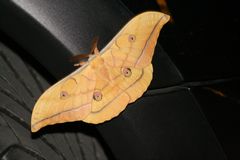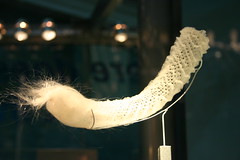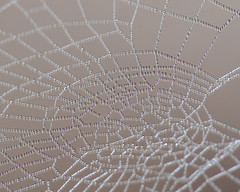ProjectsPast and current JFS projects
[Get Inspired by Nature] Inspired by Chemical Processes
This page is devoted to both Japanese and overseas examples of technology derived from the study of chemical processes used by animals and plants.
(See "Table legend" at the bottom of this page for an explanation of table content)
 Photo by Grant Bishop | Barnacle |
| Attach to boat hulls, etc. | |
| Adhesive | |
| Barnacles create a compound from several proteins to use as cement. | |
| Implants, parts adhesives | |
| Marine Biotechnology Institute | |
| AskNature: Multiple component glue aids underwater adhesion -- barnacle Amazing Nature Database: The underwater adhesive made by barnacles (Japanese only) | |
 Photo by Clemens Nestroy | Larvae of saturnid moths |
| Puts cells to sleep over winter | |
| Dormancy chemical Yamamarin | |
| These larvae use Yamamarin to suppress cell division and reversibly arrest cell activity. | |
| Suppression of cancer cell division | |
| Professor Koichi Suzuki, Faculty of Agriculture, Iwate University | |
| Amazing Nature Database: Saturnid moths that can put cancer cells to sleep (Japanese only) | |
 Photo by Vietnam plants | Shield and stink bugs |
| Display vivid coloration | |
| Use of structural colors to bring out color | |
| Protect themselves from predators by using light reflected off the tiny knobs and membranes coating their backs to produce vivid colors | |
| Cosmetics that reflect light, particularly ultraviolet radiation | |
| Amazing Nature Database: How shield bugs use good looks to keep enemies at bay (Japanese only) | |
 Photo by Ryan Somma | Venus' Flower Basket |
| Creates a glassy skeleton at normal temperature | |
| Glass fiber | |
| Creates a basket of delicate glass fibers that it makes by converting silicic acid in sea water to silica | |
| Production of glass at room temperature rather than the high temperatures that we currently use | |
| Bell Laboratories, USA | |
| AskNature: Filter feeding moves water -- Venus flower basket Amazing Nature Database: The Venus' Flower Basket, a master glass fiber craftsman (Japanese only) | |
 | Microalgae (Pseudochoricystis, etc.) |
| Makes oil through photosynthesis | |
| Biofuel | |
| Pseudochorisystis makes oily organic substance through photosynthesis. | |
| Biofuel that can be cultured/produced continuously | |
| Institute for Advanced Biosciences, Keio University /Denso | |
| Amazing Nature Database: Oil-producing microalgae (Japanese only) | |
 | Lac insect |
| Manufactures a natural resin to coat its body | |
| Natural coating | |
| Lac insects suck tree sap to synthesize a resin known as lac that they secrete to cover their bodies, protecting the colony and larvae | |
| Coating, adhesive, dye or fragrance that is not degraded by ultraviolet radiation | |
| Amazing Nature Database: The protective coating manufactured by lac insects (Japanese only) | |
 Photo by Rockman of Zymurgy | Small White butterfly pupa |
| The stage between caterpillar and butterfly | |
| Pierisin | |
| The pupa secretes pierisin, a substance that destroys larval tissues not required by the adult and regenerates organs required by the adult. | |
| New anti-cancer drug with no side effects | |
| Professor Emeritus Takashi Sugimura et al., National Cancer Center | |
| Amazing Nature Database: Using the Small White to kill cancer cells (Japanese only) | |
 Photo by Fozzeee | Plants |
| Photosynthesis | |
| Discharge of electrons | |
| Plant pigments discharge electrons as well as oxygen when exposed to sunlight | |
| Electricity generation through exposing an electrode coated with dye to sunlight and gathering the discharged electrons | |
| Conceived at Ecole Polytechnique Federale de Lausanne / Konica Minolta and others | |
| Prof. Michael Gratzel, Ecole Polytechnique Federale de Lausanne Wikipedia: Dye-sensitized solar cell | |
 Photo by PictureWendy | Bacteria in panda feces |
| Digest and break down ingested plant matter | |
| Heat-resistant enzyme | |
| Breakdown of cellulose and other food fiber that is otherwise difficult to break down | |
| Microbial treatment of kitchen waste | |
| Professor Emeritus Fumiaki Taguchi, Kitasato University | |
| J-GLOBAL Japan Science and Technology Agency Link Center (Japanese only) Kankyo goo: Fumiaki Taguchi - isolating useful bacteria from panda feces and termites (Japanese only) | |
 | Anaerobic bacteria that parasitize termites |
| Digest and break down ingested plant matter | |
| Hydrogen | |
| Fermentation of raw garbage to release oxygen | |
| Use of extracted hydrogen as a source of energy | |
| Professor Emeritus Fumiaki Taguchi, Kitasato University | |
| Kankyo goo: Fumiaki Taguchi - isolating useful bacteria from panda feces and termites (Japanese only) | |
 Photo by bbum | Spider silk |
| Very fine, very strong, very elastic | |
| A strong fiber | |
| Made of protein | |
| Manufacture of biodegradable fiber that does not involve synthesis from fossil fuels | |
| Spiber, etc. | |
| AskNature: Silk is strong -- Darwin's bark spider Learning from Nature: Natural Technology (Gakken 2011 - Japanese only) | |
Table legend
| photo credit | Like ... (plant or animal) |
| What it is or does | |
| Outcome | |
| Natural process involved | |
| Potential application for human society | |
| Researcher or research organization | |
| Information source | |
This project has been funded by Hitachi Environment Foundation under its fiscal 2011 funding program for NPOs.


